3D Geophysical Post-Inversion Feature Extraction for Mineral Exploration through Fast-ICA
Abstract
1. Introduction
2. Materials and Methods
2.1. Theoretical Background
2.2. Simulation of Exploration Procedure
2.3. Independent Component Analysis (ICA)
3. Results
3.1. Simulation of Petrophysical System
3.2. Petrophysical Feature Extraction
3.3. Simulation of the Geophysical System (Forward Modeling)
3.4. Imaging System (Inverse Modeling)
3.5. Post-Inversion Feature Extraction
4. Discussion
5. Conclusions
Author Contributions
Funding
Conflicts of Interest
References
- Lelièvre, P.G.; Farquharson, C.G. Integrated Imaging for Mineral Exploration. In Integrated Imaging of the Earth: Theory and Applications; Geophysical Monograph 218; Moorkamp, M., Ed.; Wiley Online Library: Hoboken, NJ, USA, 2016; pp. 61–95. [Google Scholar] [CrossRef]
- Dentith, M.; Mudge, S.T. Geophysics for the Mineral Exploration Geoscientist; Cambridge University Press: Cambridge, UK, 2014. [Google Scholar] [CrossRef]
- Fullagar, P.K.; Hughes, N.A.; Pain, J. Drilling constrained 3D gravity inversion. Explor. Geophys. 2000, 31, 17–23. [Google Scholar] [CrossRef]
- Wisen, R.; Christiansen, A.V. Laterally and mutually constrained inversion of surface wave seismic data and resistivity data. J. Environ. Eng. Geophys. 2005, 10, 251–262. [Google Scholar] [CrossRef][Green Version]
- Lelièvre, P.G. Integrating Geologic and Geophysical Data through Advanced Constrained Inversions. Ph.D. Thesis, The University of British Columbia, Vancouver, BC, Canada, 2009. Available online: http://hdl.handle.net/2429/6661 (accessed on 29 July 2021).
- Lelièvre, P.G.; Oldenburg, D.W.; Williams, N.C. Integrating geological and geophysical data through advanced constrained inversions. Explor. Geophys. 2009, 40, 334–341. [Google Scholar] [CrossRef]
- Lines, L.R.; Schultz, A.K.; Treitel, S. Cooperative inversion of geophysical data. Geophysics 1988, 53, 8–20. [Google Scholar] [CrossRef]
- Paasche, H.; Tronicke, J. Cooperative inversion of 2D geophysical data sets: A zonal approach based on fuzzy c-means cluster analysis. Geophysics 2007, 72, A35–A39. [Google Scholar] [CrossRef]
- Haber, E.; Oldenburg, D. Joint inversion: A structural approach. Inverse Probl. 1997, 13, 63–77. [Google Scholar] [CrossRef]
- Doetsch, J.; Linde, N.; Coscia, I.; Greenhalgh, S.; Green, A. Zonation for 3D aquifer characterization based on joint inversion of multimethod crosshole geophysical data. Geophysics 2010, 75, G53–G64. [Google Scholar] [CrossRef]
- Chen, J.; Hoversten, G.M. Joint inversion of marine seismic AVA and CSEM data using statistical rock-physics models and Markov random fields. Geophysics 2012, 77, R65. [Google Scholar] [CrossRef]
- Gallardo, L.A.; Fontes, S.L.; Meju, M.A.; Buonora, M.P.; de Lugao, P. Robust geophysical integration through structure-coupled joint inversion and multispectral fusion of seismic reflection, magnetotelluric, magnetic and gravity images: Example from Santos Basin, offshore Brazil. Geophysics 2012, 77, B237–B251. [Google Scholar] [CrossRef]
- Haber, E.; Gazit, M.H. Model fusion and joint inversion. Surv. Geophys. 2013, 34, 675–695. [Google Scholar] [CrossRef]
- Comon, P. Independent component analysis: A new concept. Signal Process. 1994, 36, 287–314. [Google Scholar] [CrossRef]
- Hyvärinen, A.; Oja, E. A fast fixed-point algorithm for ICA. Neural Comput. 1997, 9, 1483–1492. [Google Scholar] [CrossRef]
- Hyvärinen, A.; Karhunen, J.; Oja, E. Independent component analysis. In Adaptive and Learning Systems for Signal Processing, Communications, and Control; Haykin, S., Ed.; John Wiley & Sons, Inc.: Hoboken, NJ, USA, 2001. [Google Scholar] [CrossRef]
- Hyvärinen, A. Independent component analysis: Recent advances. Phil. Trans. R. Soc. A 2013, 371, 1984. [Google Scholar] [CrossRef] [PubMed]
- Bayliss, J.D.; Gualtieri, J.A.; Cromp, R.F. Analyzing hyperspectral data with independent component analysis. In Proceedings of the 26th AIPR Workshop: Exploiting New Image Sources and Sensors, Washington, DC, USA, 15–17 October 1998; International Society for Optics and Photonics: Washington, DC, USA, 1998; pp. 133–143. [Google Scholar]
- Amato, U.; Antoniadis, A.; Cuomo, V.; Cutillo, L.; Franzese, M.; Murino, L.; Serio, C. Statistical cloud detection from SEVIRI multispectral images. Remote Sens. Environ. 2008, 112, 750–766. Available online: https://spie.org/Publications/Proceedings/Paper/10.1117/12.300050 (accessed on 29 July 2021). [CrossRef]
- Barnie, T.; Oppenheimer, C. Extracting high temperature event radiance from satellite images and correcting for saturation using Independent Component Analysis. Remote Sens. Environ. 2015, 158, 56–68. [Google Scholar] [CrossRef]
- Liu, B.; Dai, W.; Peng, W.; Meng, X. Spatiotemporal analysis of GPS time series in vertical direction using independent component analysis. Earth Planets Space 2015, 67, 189. [Google Scholar] [CrossRef]
- Choudrey, R.; Roberts, S. Variational mixture of Bayesian independent component analysers. Neural Comput. 2002, 15, 213–252. [Google Scholar] [CrossRef]
- Beckmann, C.F.; Smith, S.M. Probabilistic independent component analysis for functional magnetic resonance imaging. IEEE Trans. Med. Imaging 2004, 23, 137–152. [Google Scholar] [CrossRef]
- Griffanti, L.; Salimi-Khorshidi, G.; Beckmann, C.F.; Auerbach, E.J.; Douaud, G.; Sexton, C.E.; Zsoldos, E.; Ebmeier, K.P.; Filippini, N.; Mackay, C.E. ICA-based artefact removal and accelerated fMRI acquisition for improved resting state network imaging. NeuroImage 2014, 95, 232–247. [Google Scholar] [CrossRef]
- Jenssen, R.; Eltoft, T. Independent component analysis for texture segmentation. Pattern Recognit. 2003, 36, 2301–2315. [Google Scholar] [CrossRef]
- Zou, W.; Li, Y.; Lo, K.C.; Chi, Z. Improvement of image classification with Wavelet and Independent Component Analysis (ICA) based on Structured Neural Networks. In Proceedings of the IEEE International Conference on Neural Networks 2006, Vancouver, BC, Canada, 24–29 July 2006; pp. 3949–3954. [Google Scholar] [CrossRef]
- Van der Baan, M. PP/PS Wavefield separation by independent component analysis. Geophys. J. Int. 2006, 166, 339–348. [Google Scholar] [CrossRef]
- Honório, B.C.Z.; Sanchetta, A.C.; Leite, E.P.; Vidal, A.C. Independent component spectral analysis. Interpretation 2014, 2, 1. [Google Scholar] [CrossRef]
- Li, Y.; Oldenburg, D.W. 3D inversion of magnetic data. Geophysics 1997, 61, 394–408. [Google Scholar] [CrossRef]
- Li, Y.; Oldenburg, D.W. 3D inversion of induced polarization data. Geophysics 2000, 65, 1931–1945. [Google Scholar] [CrossRef]
- Tutorial: 2D and 3D Electrical Imaging Surveys: Geotomo Software. Available online: http://www.geotomosoft.com/downloads.php (accessed on 29 July 2021).
- Oldenburg, D.W.; Li, Y. Inversion of induced polarization data. Geophysics 1994, 59, 1327–1341. [Google Scholar] [CrossRef]
- Claerbout, J.F.; Muir, F. Robust modeling with erratic data. Geophysics 1973, 38, 826–844. [Google Scholar] [CrossRef]
- Loke, M.H.; Acworth, I.; Dahlin, T. A comparison of smooth and blocky inversion methods in 2D electrical imaging surveys. Explor. Geophys. 2003, 34, 182–187. [Google Scholar] [CrossRef]
- Portniaguine, O.; Zhdanov, M.S. 3-D magnetic inversion with data compression and image focusing. Geophysics 2002, 67, 1532–1541. [Google Scholar] [CrossRef]
- Sharpening using Iterative Reweighting Inversion: Oasis Montaj Best Practice Guide. Available online: http://updates.geosoft.com/downloads/files/how-to-guides/Best-Practice-Guide_Sharpening_using_IRI.pdf (accessed on 29 July 2021).
- Hyvärinen, A.; Oja, E. Independent component analysis: Algorithms and applications. Neural Netw. 2000, 13, 411–430. [Google Scholar] [CrossRef]
- Trauth, M.H. MATLAB Recipes for Earth Sciences, 4th ed.; Springer: Berlin/Heidelberg, Germany, 2015. [Google Scholar] [CrossRef]
- Hyvärinen, A.; Karhunen, J.; Oja, E. Independent Component Analysis; Wiley Interscience Publication: New York, NY, USA, 2002. [Google Scholar] [CrossRef]
- Cherry, E.C. Some experiments on the recognition of speech, with one and with two ears. J. Acoust. Soc. Am. 1953, 25, 975–979. [Google Scholar] [CrossRef]
- Von der Malsburg, C.; Schneider, W. A neural cocktail-party processor. Biol. Cybern. 1986, 54, 29–40. [Google Scholar] [CrossRef]
- Brown, G.D.; Yamada, S.; Sejnowski, T.J. Independent component analysis at the neural cocktail party. Trends Neurosci. 2001, 24, 54–63. [Google Scholar] [CrossRef]
- Noddy Structural and Geological Modeling: Reference Manual, TecTask, Encom Technology Pty Ltd. Available online: https://tectonique.net/noddy (accessed on 29 July 2021).

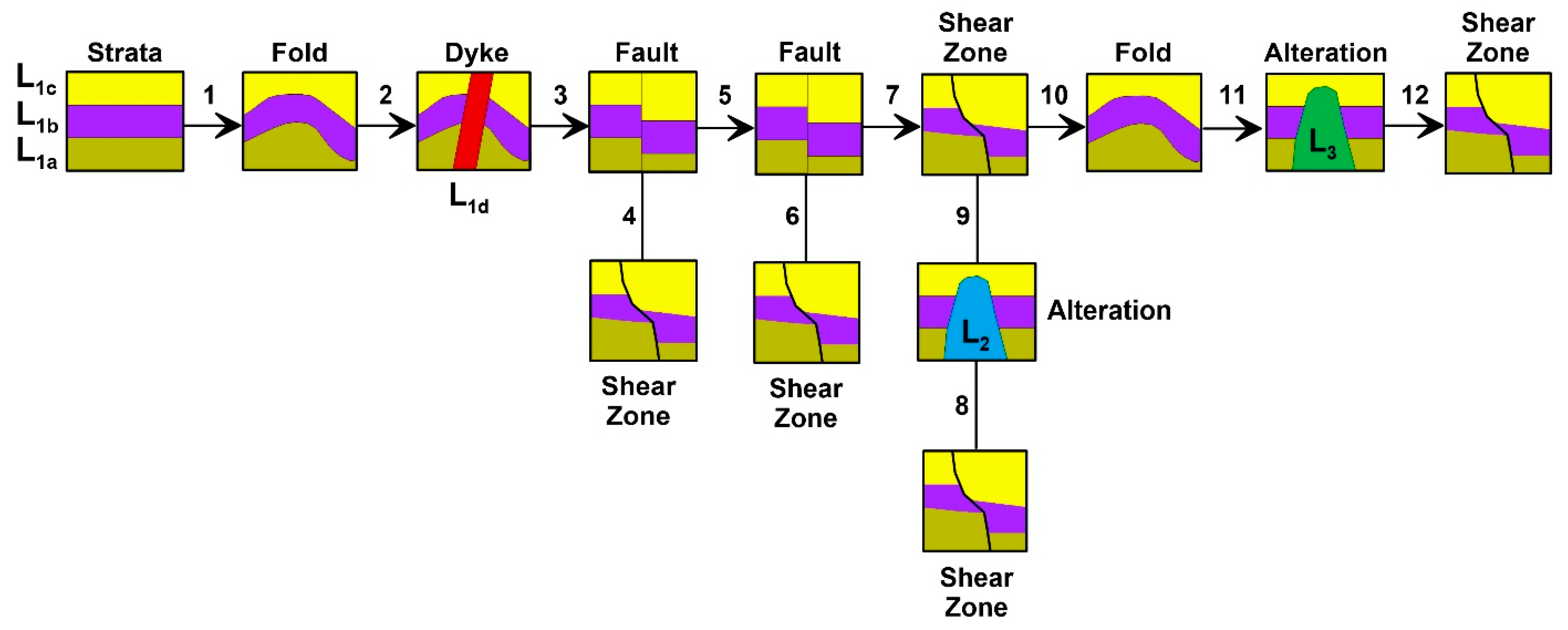
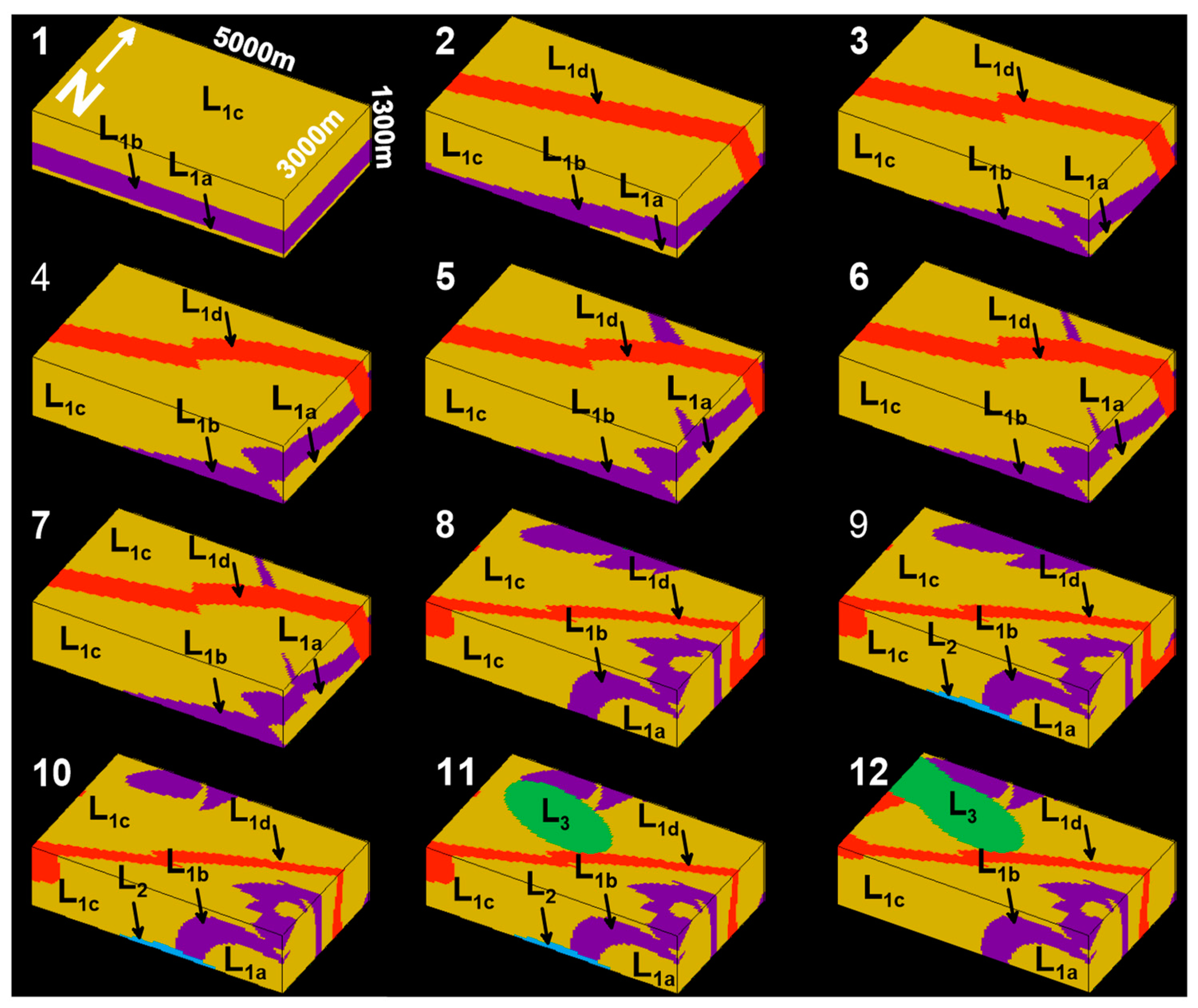
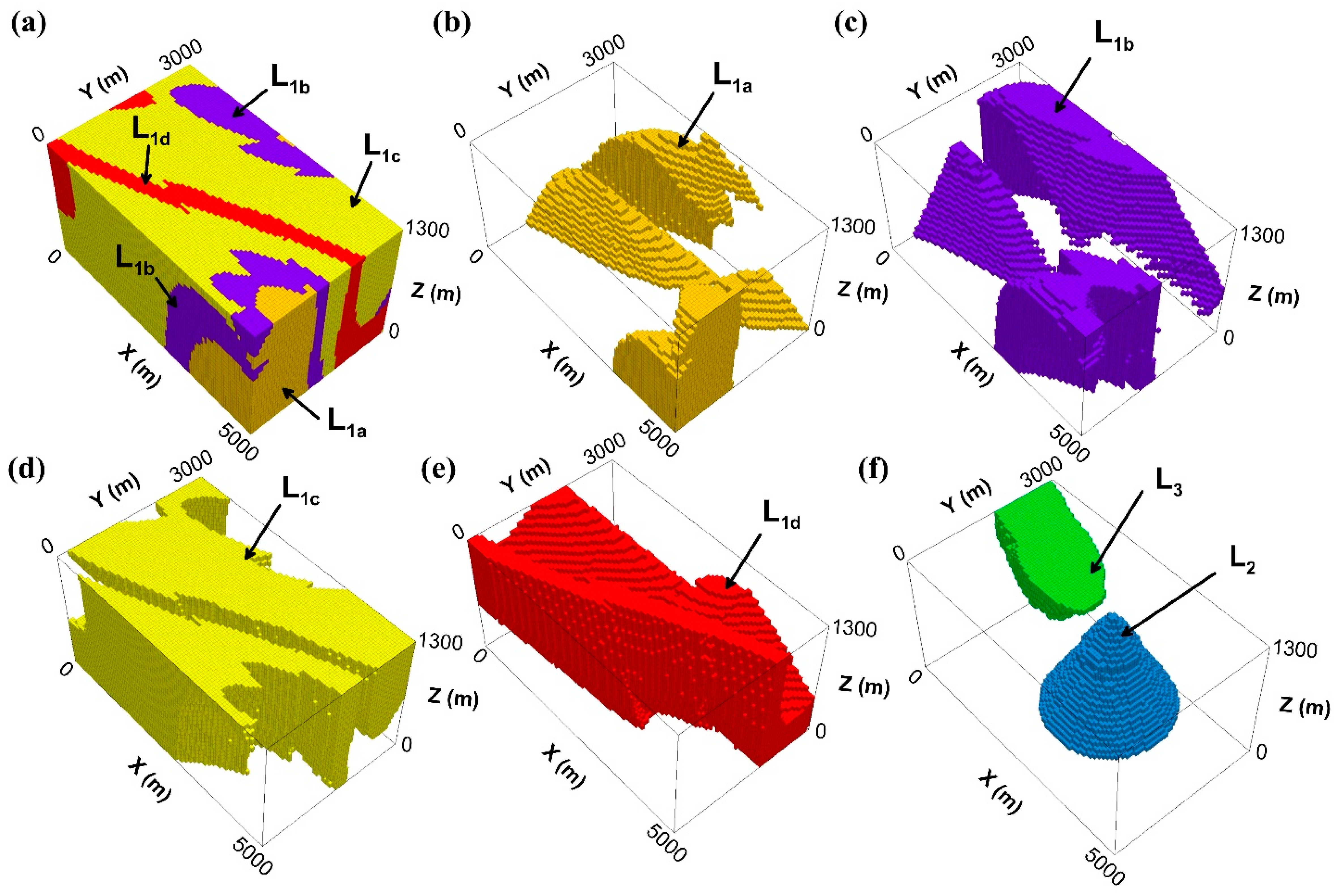


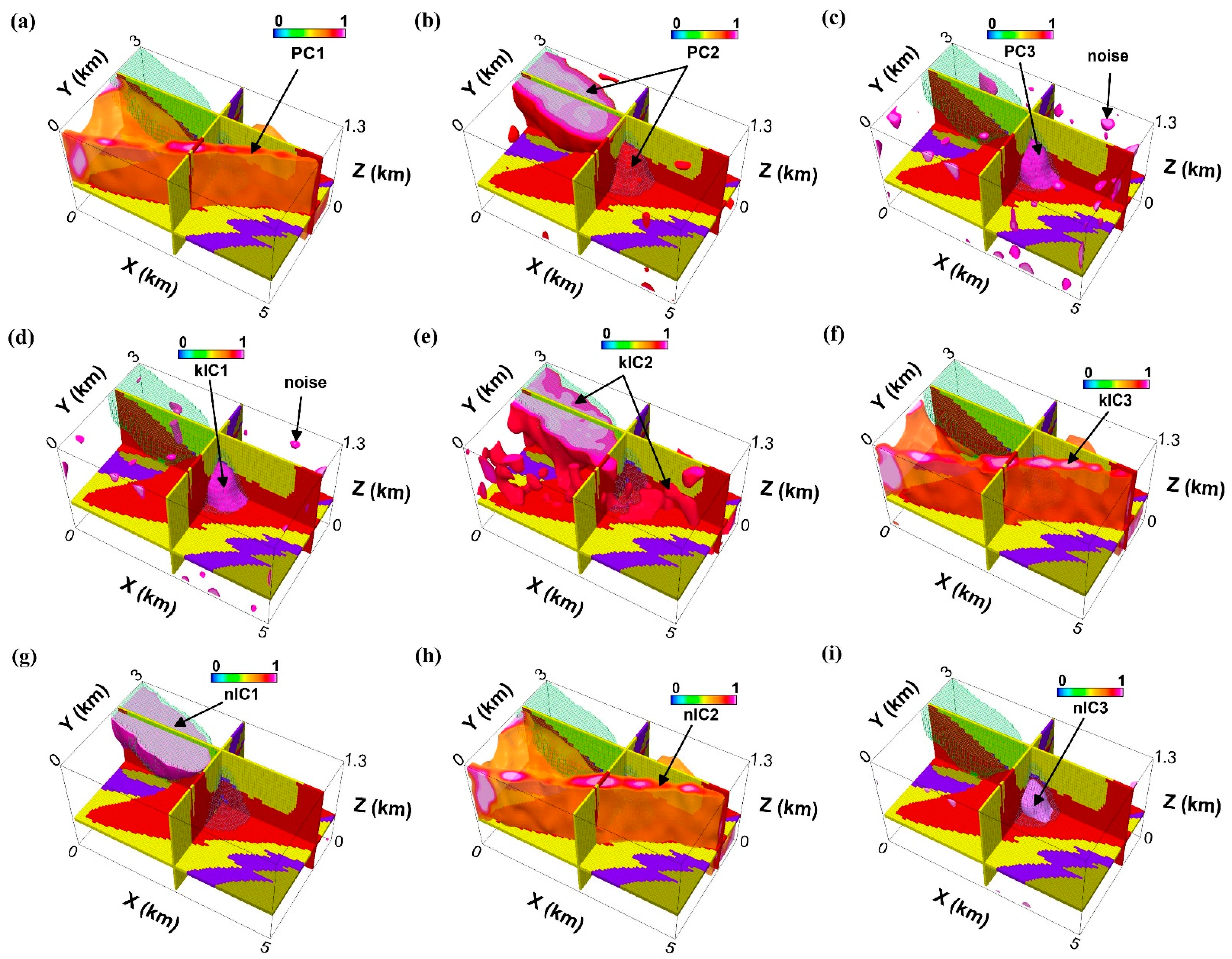

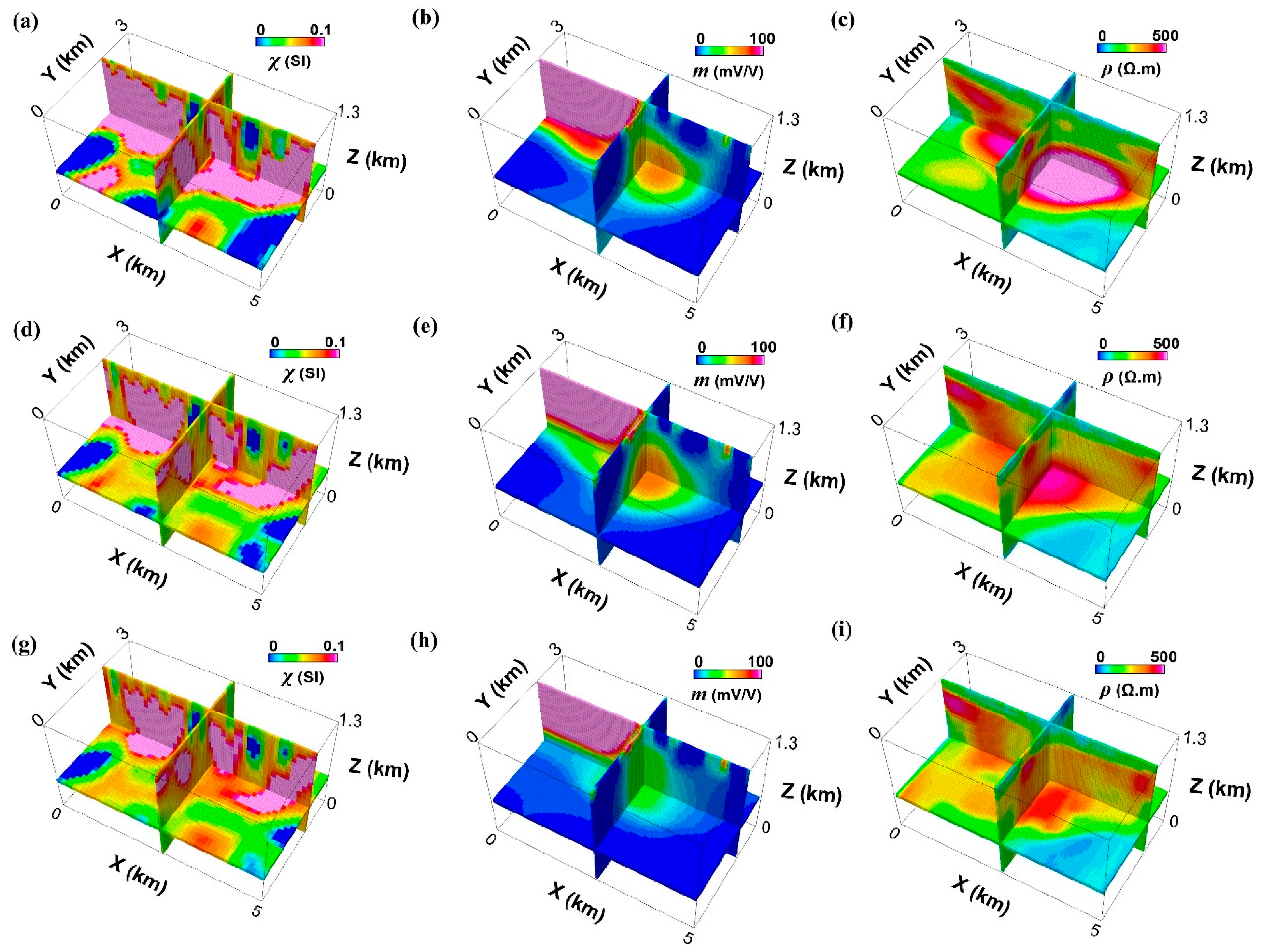
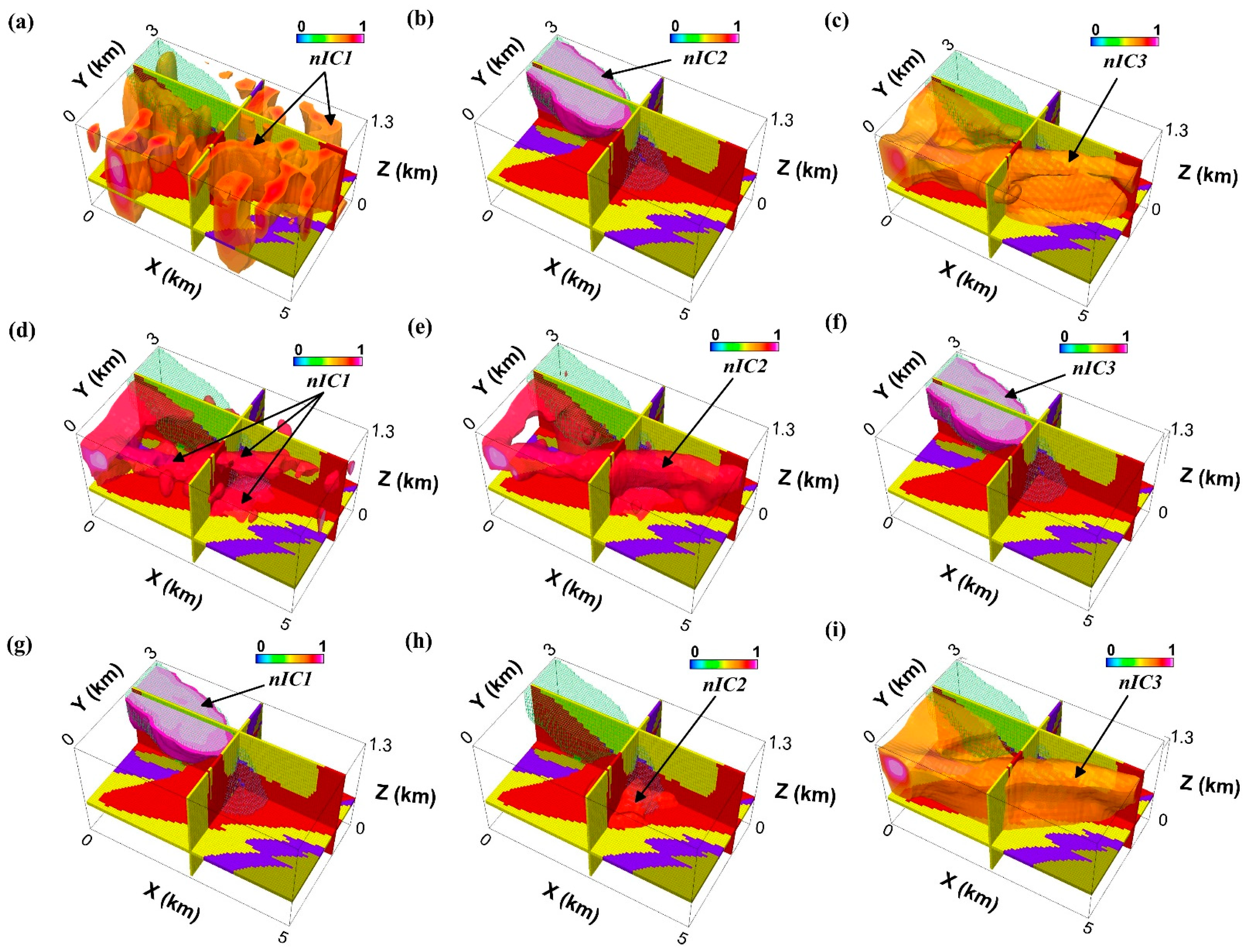
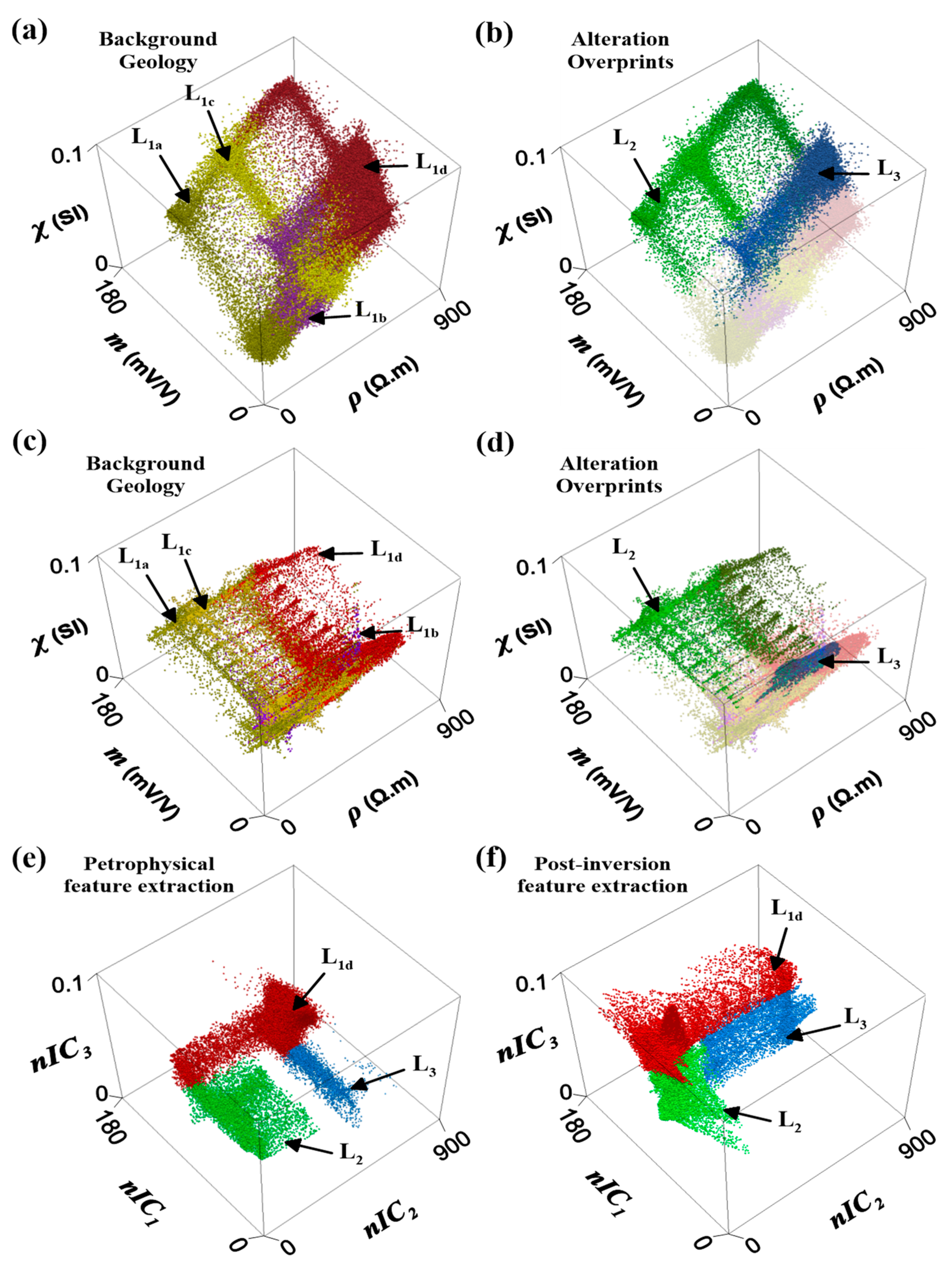
Publisher’s Note: MDPI stays neutral with regard to jurisdictional claims in published maps and institutional affiliations. |
© 2021 by the authors. Licensee MDPI, Basel, Switzerland. This article is an open access article distributed under the terms and conditions of the Creative Commons Attribution (CC BY) license (https://creativecommons.org/licenses/by/4.0/).
Share and Cite
Abbassi, B.; Cheng, L.-Z. 3D Geophysical Post-Inversion Feature Extraction for Mineral Exploration through Fast-ICA. Minerals 2021, 11, 959. https://doi.org/10.3390/min11090959
Abbassi B, Cheng L-Z. 3D Geophysical Post-Inversion Feature Extraction for Mineral Exploration through Fast-ICA. Minerals. 2021; 11(9):959. https://doi.org/10.3390/min11090959
Chicago/Turabian StyleAbbassi, Bahman, and Li-Zhen Cheng. 2021. "3D Geophysical Post-Inversion Feature Extraction for Mineral Exploration through Fast-ICA" Minerals 11, no. 9: 959. https://doi.org/10.3390/min11090959
APA StyleAbbassi, B., & Cheng, L.-Z. (2021). 3D Geophysical Post-Inversion Feature Extraction for Mineral Exploration through Fast-ICA. Minerals, 11(9), 959. https://doi.org/10.3390/min11090959





